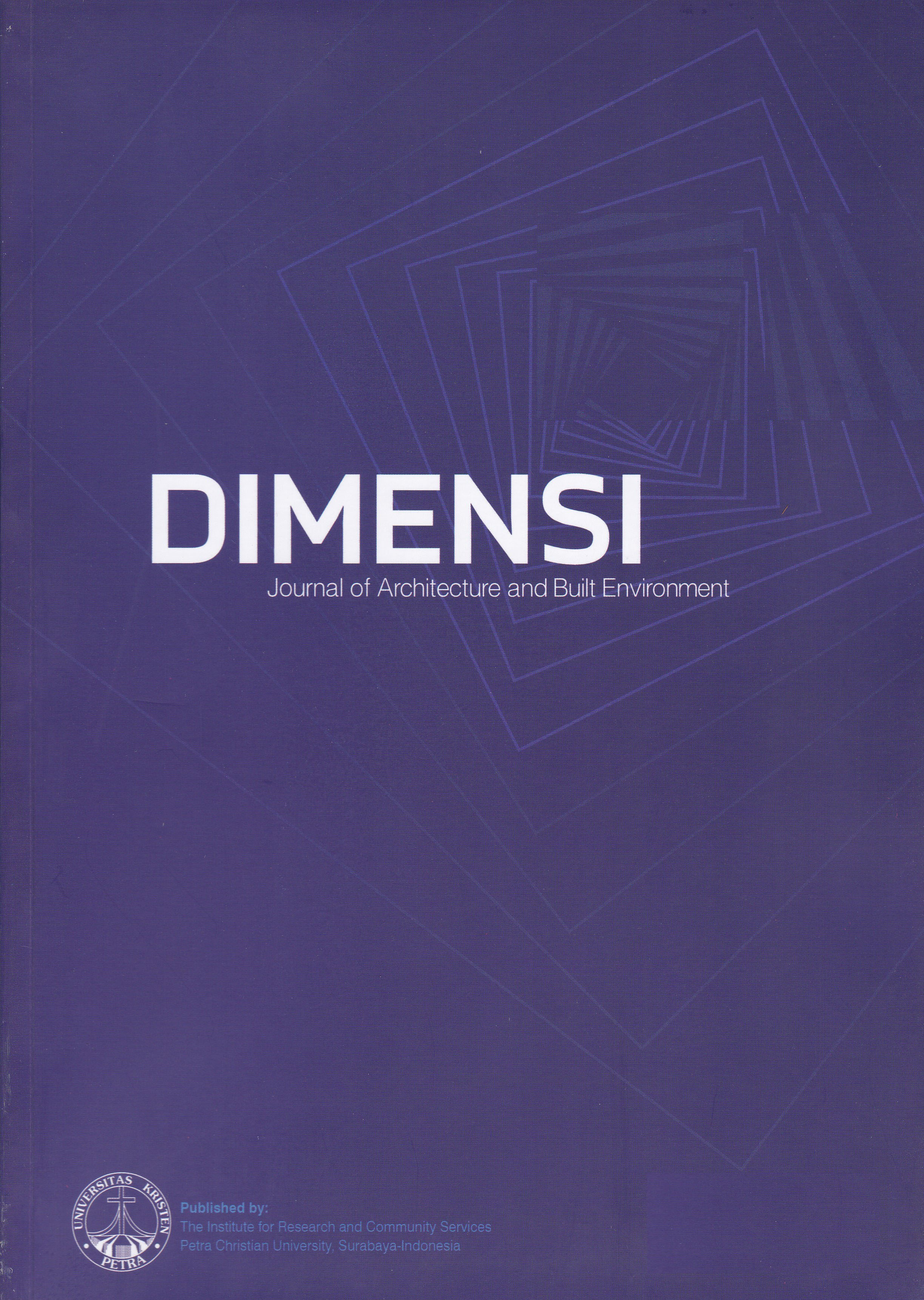UNDERSTANDING STUDENTS’ PREFERENCES OF COMMON SPACES FROM A PHYSICAL AND PSYCHOLOGICAL PERSPECTIVE
DOI:
https://doi.org/10.9744/dimensi.49.2.99-104Keywords:
Common Space in university, students' perspective, physical and psychological factors, active leaningAbstract
Although common spaces in a university can serve an important role for adolescents in learning with colleagues and developing their ideas, common spaces have received insufficient research attention. Therefore, this study identified the characteristics of physical environments that promote active leaning among university students and the psychological aspects of students’ modes of being in common spaces. We conducted an online questionnaire and analyzed the data (N = 144; 86 men and 58 women; mean age = 23.5 ± 5.8 years) using cluster analysis and text-mining. We revealed three types of physical characteristics that promote students’ active learning and five groups of students’ modes of being in common spaces. The physical and psychological characteristics of the common spaces that promote active learning are discussed.
Downloads
References
Alapieti, T., Mikkola, R., Pasanen, P., & Salonen, H. (2020). The influence of wooden interior materi-als on indoor environment: a review. European Journal of Wood and Wood Products, 78(4), 617–634. https://doi.org/10.1007/s00107-020-01532-x
Bonnand, S., & Donahue, T. (2010). What's in a Name? The Evolving Library Commons Con-cept. College & Undergraduate Libraries, 17, 225-233, DOI:10.1080/10691316.2010.487443
Carnell, B. (2017). Connecting Physical University Spaces with Research-Based Education Strategy. Journal of Learning Spaces, 6(2), 1–12.
Creswell, J., Plano Clark, V., Gutmann, M., & Hanson, W. (2003). An Expandede Typology for Classifying Mixed Methods Research Into Designs. In Advanced mixed methods research designs (In A. Tash, 159–196). Sage.
Davarpanah, S. (2017). Emphasis on Environment psychology principles. 8(6), 1038–1049.
Davies, D., Jindal-Snape, D., Collier, C., Digby, R., Hay, P., & Howe, A. (2013). Creative learning environments in education-A systematic litera¬ture review. Thinking Skills and Creativity, 8(1), 80–91. https://doi.org/10.1016/j.tsc.2012.07.004
Douglas, D., & Gifford, R. (2001). Evaluation of the physical classroom by students and professors: A lens model approach. Educational Research, 43(3), 295–309. https://doi.org/10.1080/0013188 0110081053
Elliot, A. J., & Maier, M. A. (2014). Color psychology: Effects of perceiving color on psychological functioning in humans. Annual Review of Psychology, 65, 95–120. https://doi.org/10.1146/annurev-psych-010213-115035
Halsband, F. (2005). Campuses in place. Places, 17(1). https://placesjournal.org/assets/legacy/pdfs/campuses-in-place.pdf
Hami, A., & Abdi, B. (2021). Students’ landscaping preferences for open spaces for their campus environment. Indoor and Built Environment, 30(1), 87–98. https://doi.org/10.1177/1420326 X19887207
Harvey, E., & Kenyon, M. (2013). Classroom Seating Considerations for 21st Century Students and Faculty. Journal of Learning Spaces, 2(1).
Higgins, S., Hall, E., Wall, K., Woolner, P., & McCaughey, C. (2005). The impact of school environments: a literature review.
Ishiguro, F., Uno, T., Nomura, T., Nanba, Y., & Kuwa¬hara, K. (2018). Shujitsu daigaku Shujitu tankidaigaku niokeru kyoudougakushuu supesu no riyoujoukyou ni kansuru tyousahoukoku. (A report on the use situation of collaborative learning spaces of Shujitsu University and Shujitsu Junior College). 205–223.
Joye, Y. (2007). Architectural Lessons From Environ-mental Psychology: The Case of Biophilic Archi-tecture. Review of General Psychology, 11(4), 305–328. https://doi.org/10.1037/1089-2680.11. 4.305
Lau, S. S. Y., Gou, Z., & Liu, Y. (2014). Healthy campus by open space design: Approaches and guidelines. Frontiers of Architectural Research, 3(4), 452–467. https://doi.org/10.1016/j.foar.2014.06.006
Manca, S., Cerina, V., Tobia, V., Sacchi, S., & Fornara, F. (2020). The effect of school design on users’ responses: A systematic review (2008-2017). Sustainability (Switzerland), 12(8), 1–37. https://doi.org/10.3390/SU12083453
Okuda, Y. (2012). Shinrigaku karamita wagakunino raningu komonzu niokeru manabino doukouto kongono kadai. The Trend and Future Subject of the Learning Commons: From Psychological Perspective. Academic Knowledge Archives of Gunma Institutes, 12, 91–103.
Peker, E., & Ataöv, A. (2020). Exploring the ways in which campus open space design influences students’ learning experiences. Landscape Research, 45(3), 310–326. https://doi.org/10.1080/01426397.2019.1622661
Qualtrics. (2021). What is cluster analysis? When should you use it for your survey results?
Rands, M., & Gansemer-Topf, A. (2017). The Room Itself is Active: How Classroom Design Impacts Student Engagement. Journal of Learning Spaces, 6(1), 26–33.
Shi, S., Gou, Z., & Chen, L.H.C. (2014) How does enclosure influence environmental preferences? A cognitive study on urban public open spaces in Hong Kong. Sustainable Cities and Society, 13,148-156. https://doi.org/10.1016/j.scs.2014. 04.011
Stedman, R. C. (2003). Is it really just a social construction?: The contribution of the physical environment to sense of place. Society and Natu-ral Resources, 16(8), 671–685. https://doi.org/10.1080/08941920309189
Sun, M., Nakashima, T., Yoshimura, Y., Honden, A., Nakagawa, T., Saijo, H., Watanabe, Y., Ajimi, T., Yasunari, S., Yamada, Y., Nagano, J., Okamoto, T., Ishikawa, H., Ohnuki, K., Fujimoto, N., & Shimizu, K. (2020). Effects and interaction of different interior material treatment and personal preference on psychological and physiological responses in living environment. Journal of Wood Science, 66(1). https://doi.org/10.1186/s10086-020-01910-2
Suzuki, T. (1993). Hito no Ikata karano Kankyo dezain: Toshi no opunsupesu no ikata. Kenchiku Gijutsu, 204–207.
Teston, L. (2020). On the nature of public interiority. Interiority, 3(1), 61–82. https://doi.org/10.7454/ in.v3i1.72
Downloads
Published
How to Cite
Issue
Section
License
Authors who publish with this journal agree to the following terms:
- Authors retain copyright and grant the journal right of first publication with the work simultaneously licensed under a Creative Commons Attribution License that allows others to share the work with an acknowledgement of the work's authorship and initial publication in this journal.
- Authors are able to enter into separate, additional contractual arrangements for the non-exclusive distribution of the journal's published version of the work (e.g., post it to an institutional repository or publish it in a book), with an acknowledgement of its initial publication in this journal.
- Authors are permitted and encouraged to post their work online (e.g., in institutional repositories or on their website) prior to and during the submission process, as it can lead to productive exchanges, as well as earlier and greater citation of published work (See The Effect of Open Access).



















